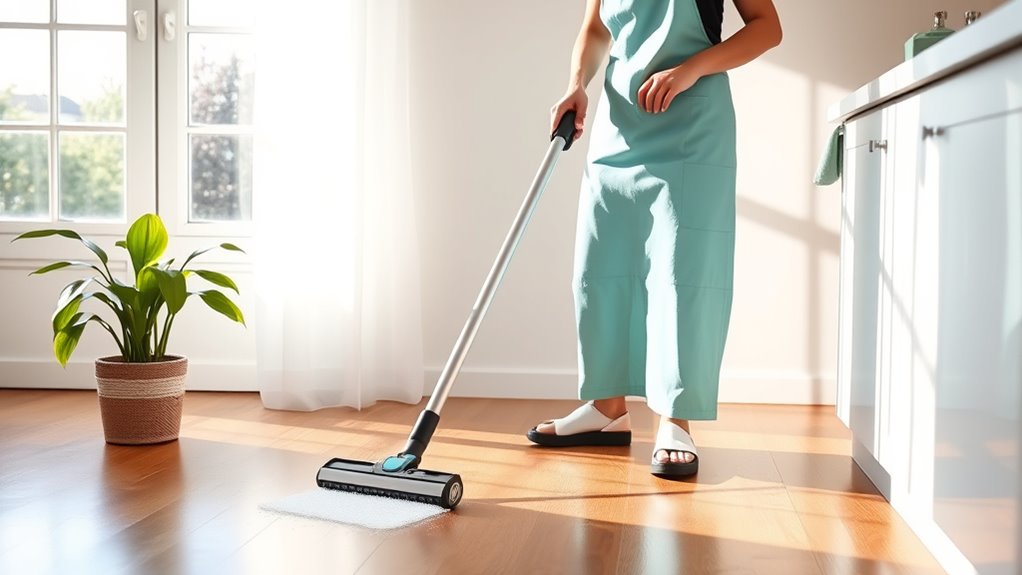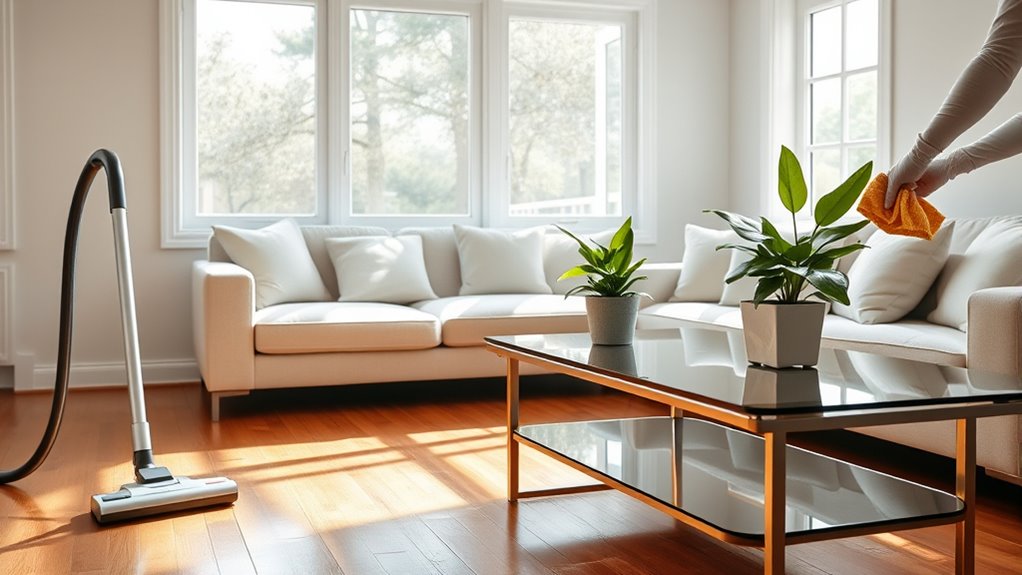To reduce allergens in your home, establish a consistent cleaning routine. Use vacuums with HEPA filters to trap pet hair and dander, and change air purifier filters every 3-6 months to maintain effectiveness. Dust surfaces with damp microfiber cloths, and wash your bedding weekly in hot water. Regularly clean curtains and focus on hidden areas like ceiling fans and baseboards. Keeping up with these practices guarantees a healthier indoor environment filled with fresher air. There’s much more you can do!
Key Takeaways
- Regularly change air purifier filters every 3-6 months to maintain air quality and reduce allergens effectively.
- Use HEPA filter vacuums to thoroughly remove pet hair and dander from carpets and furniture.
- Dust surfaces with damp microfiber cloths to trap dust and minimize allergen dispersal.
- Wash bedding weekly in hot water to eliminate dust mites and other allergens.
- Establish a consistent cleaning routine to significantly lower allergen levels and improve indoor air quality.

How often do you think about the allergens lurking in your home? If you’re like many, you might not give it much thought until you notice sneezing, itchy eyes, or a stuffy nose. Allergens can hide in the most unexpected places, from dust mites to pet dander. Fortunately, creating a cleaning routine can considerably reduce these irritants, contributing to a healthier living environment.
To start, focus on air quality. An air purifier is an excellent investment for capturing airborne allergens. However, proper air purifier maintenance is vital. Make sure to change the filters regularly—most manufacturers recommend every three to six months. This simple task keeps your air purifier functioning efficiently and guarantees it removes as many allergens as possible. You wouldn’t want to breathe in air that’s circulated through a clogged filter, right?
Next, consider the impact of your furry friends. If you have pets, pet hair removal should be a priority in your cleaning routine. Pet hair collects on furniture, carpets, and even in the air, contributing to allergy symptoms. Regularly vacuum your home using a vacuum equipped with a HEPA filter to trap pet dander and hair effectively. Don’t forget to vacuum under furniture and in corners where hair tends to accumulate. For upholstery, a lint roller can be a quick and effective tool for removing hair from couches and chairs.
In addition to vacuuming, dusting is essential. Use a damp microfiber cloth to wipe surfaces, which will help trap dust instead of just moving it around. Pay attention to areas that often get overlooked, like ceiling fans, baseboards, and blinds. You might be surprised at how much dust collects in these spots!
Finally, consider washing your bedding and curtains regularly. Allergens can settle in these fabrics and contribute to poor air quality. Aim to wash your sheets weekly in hot water to eliminate dust mites and other allergens. Curtains should be machine washable or cleaned according to the manufacturer’s instructions, guaranteeing they remain fresh and clean. Additionally, maintaining a clean environment may help reduce the risk of kidney stone prevention, particularly if you’re mindful of substances that can exacerbate health issues.
Frequently Asked Questions
How Often Should I Wash My Pet’s Bedding?
You should wash your pet’s bedding at least once a week to maintain proper pet hygiene and guarantee a clean environment. Regular bedding maintenance helps reduce odors and allergens that can affect both you and your pet. If your pet has allergies or sheds a lot, consider washing it more frequently. Don’t forget to dry it thoroughly to keep it fresh and comfortable for your furry friend!
Can Indoor Plants Help Reduce Allergens?
Yes, indoor plants can help reduce allergens! They improve air quality by absorbing carbon dioxide and releasing oxygen. Certain plants, like spider plants and peace lilies, also filter out common pollutants. By incorporating indoor plant benefits into your allergen reduction strategies, you create a healthier environment. Just remember to choose low-allergen plants and keep them well-maintained. You’ll enjoy better air quality while adding a touch of nature to your home!
What Are the Best Vacuum Cleaners for Allergens?
When you’re tackling allergens, what’s better than a high-quality vacuum cleaner? For the best results, look for vacuums with HEPA filters, as they trap tiny particles effectively. Brands like Dyson, Shark, and Miele excel in this area. Don’t forget about vacuum maintenance; regular filter changes and cleanings keep your vacuum running efficiently. Investing in a model designed for allergens can make a significant difference in your indoor air quality.
Is It Necessary to Use Air Purifiers?
Yes, using air purifiers is necessary if you’re serious about improving your indoor air quality. Their effectiveness in reducing allergens like dust, pollen, and pet dander is proven. When choosing air purifiers, consider factors like filter type and room size to guarantee ideal performance. A good air purifier can considerably enhance your home’s air quality, making it a valuable addition to your cleaning routine for a healthier living environment.
How Can I Reduce Dust in My Home?
To reduce dust in your home, start with strategic air filtration. Swap out your filters regularly to trap those pesky dust mites. Next, dust surfaces diligently with damp cloths to prevent particles from flying around. Consider decluttering to minimize dust-harboring areas. Vacuum carpets and rugs frequently, using a HEPA filter for maximum mite capture. Ultimately, wash bedding weekly in hot water to keep those dust-loving critters at bay. You’ll breathe easier!
Conclusion
So, while you might think a little dust is harmless, it’s actually a tiny fortress for allergens just waiting to wreak havoc. By embracing a regular cleaning routine, you’re not just tidying up; you’re declaring war on those sneaky invaders. Ironically, the more you clean, the less you notice the dust, leading you to believe your home is spotless. But remember, it’s the unseen battles that make your sanctuary truly safe. Keep scrubbing, and breathe easy!










